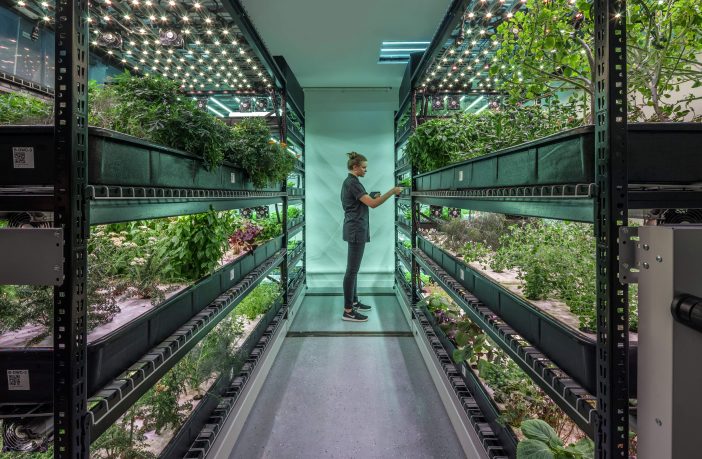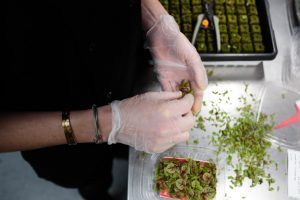Urban farming isn’t a new phenomenon. In the past, many city dwellers produced their own food in city farms and allotments. Sadly, growing urbanisation and busier lifestyles have seen this trend decline in recent decades. But now, new developments might hold the key to the return of urban farms. Is farming going underground? By Elaine Kavanagh
Farming, like any other human activity, is constantly evolving to meet the challenges of the future. And there’s plenty of those: more mouths to feed, crop damage caused by extreme weather events, growing cities, and a need to reduce our use of resources. These are just some of the issues farmers will be tackling in the coming years.
The Farm of the Future is Here
Vertical farming is a new take on agriculture with the potential to address some of these problems. This type of farming involves the indoor cultivation of crops close to urban areas. Plants grow in stacked layers without soil and the environment is strictly controlled, with LED lights doing the work of the sun.
A major benefit of vertical farming is a marked reduction in food miles. Since produce can be grown close to its point of sale, there’s no need for food to travel thousands of miles. Less food miles means a lower carbon footprint, vitally important these days. Plus you get fresher, tastier, more nutritious fruit and veggies.
There are other advantages too. The indoor environment protects crops from floods, droughts or storms. More crops can be produced because growing times are faster, space is used efficiently, and year-round growth is possible. Water requirements are vastly reduced when compared to traditional agriculture, as is the potential for contamination of water supplies. There isn’t even a need for pesticides.


And as if all that wasn’t enough, it’s even possible to regulate the flavour, texture, colour and vitamin content of crops by adjusting the intensity and colour of the LED lights. Ten years ago, vertical farming was viewed as the farm of the future. Now it’s growing into a promising industry with the potential to supplement traditional agricultural output.
Big Business
Aerofarms, a US firm, is the leading commercial operator with a patented system of aeroponics and 100,000 square feet of growing space at two New Jersey locations. And now, a new player in the US, called Plenty, plan to build huge vertical farms just outside major cities, close to distribution centres.
In Europe, vertical farms have been mostly limited to research and development facilities or specialist production. Not for long though, because Philips Lighting and Staay Food Group plan to open the first large-scale commercial vertical farm in Europe. Located in the Netherlands, it will be adjacent to the Staay Foods’ packaging facility for ready-to-eat salads. So, lettuce grown on the farm can be packaged while it is at its freshest.
We have even begun to make inroads into this area in Ireland. The Little Pharma produces hydroponically grown barley and wheat grasses, which they juice and bottle themselves. You can find out more about this enterprising business or buy their wheatgrass and barley-grass shots here.
Going Underground
So where to next for urban farmers? The answer could lie in one of the last unexplored frontiers: underground. Set-up costs are a major factor for vertical farmers; by taking advantage of cheap unwanted underground space, the high cost of urban premises can be avoided. It seems like a no-brainer for a business like underground farming, where an absence of sunlight is a fundamental requirement.
But how easy is it to identify and convert, or indeed build underground spaces? Well, while it’s simple enough to identify existing locations using 3D mapping, building underneath established urban areas can be difficult. In a 2012 report, the International Tunnelling and Underground Space Association noted that, while often the only disruption occurs at access shafts or entrances, underground construction can impact the environment. The potential effects need to be fully assessed during the decision-making process.
Yet when planning new urban centres, some experts feel underground construction should be considered from the start. According to Wout Broere, Assistant Professor of Underground Space Technology at Delft University in Holland, building underground offers many advantages, including protection against natural disasters and a more focused utilisation of above ground space. However, he also notes that many planners simply aren’t aware of the opportunities that exist underground.
Trailblazers
This awareness is beginning to increase, however. Some forward-thinking business people have already begun to consider underground space as a location for vertical farming. In Paris, for example, city planners are in the process of refurbishing disused underground sites. An urban farm was proposed for one of the sites, although unfortunately it didn’t make the final cut. Thirty-four underground tunnels, car parks and train stations were up for grabs as part of the project, called Subterranean Secrets of Paris.
In London, a hydroponic farm called Growing Underground operates from a former World War II bomb shelter thirty three metres below the busy city streets. Since 2015 it has been producing micro greens (nutrient-dense seedlings or sprouts of vegetables and herbs) and distributing them to local suppliers. You can buy produce from Growing Underground at various London wholefood stores and even from Marks & Spencer and Waitrose branches in the city.
Apart from being pesticide-free, Growing Underground also uses 70% less water than traditional farming and is carbon neutral. The reception has been positive; owners Stephen Dring and Richard Ballard have appeared at many events and talks. They plan to expand their operations to several more sites in the UK and at least one abroad.
- Goggin’s Hill Tunnel, 20 minutes from Cork City
- Interior of the tunnel – could this be an underground farm?
So, what about forgotten or abandoned spaces hidden beneath Irish city streets – could they be considered for underground farming? In Dublin, for instance, a pedestrian tunnel beneath James Street connects the two sides of the Guinness Brewery. There’s also a World War II air raid shelter in Merrion Square. And twenty minutes outside Cork City there’s an abandoned railway tunnel called Goggins Hill. Urban farms could represent an innovative new use for locations like these.
Lower Running Costs
Besides, it’s not just set-up costs that can be reduced by going underground. A South Korean company called Nexton recently opened a vertical farm inside a former highway tunnel because the unique location helped cut running costs. Inside the tunnel, the climate stays at a constant ten to twenty degrees, thus reducing the costs involved in heating and cooling.
The savings, combined with Nexton’s technology and growing systems, have enabled the company to “dramatically cut down on the cost structure which has plagued the profitability and viability of the indoor vertical farming business,” according to Chief Technology Officer, Dave Daewoong Suh. With temperatures becoming more extreme, the moderating effect of underground spaces could be a godsend for food production.
Only 16% of land in South Korea is farmland, and its rural population has halved over the past forty years despite the country’s general population increase during this time. With its agricultural workforce shrinking, the South Korean Agriculture Ministry plan to invest in developing more urban farms which it sees as key to developing a sustainable model of agriculture.
Growing to Order
In New York, an underground farm has cleverly tailored its underground space to meet specific needs of the above-ground environment. Founded in 2016 by Rob Laing, and situated in the basement of high-end restaurant Atera, Farm.One produces greens and herbs all year round, just minutes away from its customers in the restaurant industry.
- From farm to plate at Farm.One
- Photos: Sarah Blesener.
Micro-greens, edible flowers and rare herbs are grown to order for some of New York’s finest restaurants. The produce is delivered by bike and subway. You can even book a tour of Farm. One or take a class in hydroponics.
In the future, every restaurant or supermarket could have an underground space with produce grown for immediate sale or consumption. With fresher and tastier food for consumers, plus added environmental benefits, underground farming sounds like a win-win situation!









